Sliding Time
Usage
The Circuit Breaker has 3 possible states:
CLOSEDOPENHALF_OPEN
When the circuit is opened, all the iterations are failing fast
When the circuit is half opened, a certain number of iterations are authorized. When this number is reached, the failure and slow call rate thresholds are checked to see if the circuit should be opened or closed.
When the circuit is closed, a sliding window is used to store the outcome of calls. The time-based sliding window calculates the outcome of the last calls received during the last N milliseconds, and decides if the circuit should be opened (if the failure or slow call rate thresholds are exceeded) For example, if the time window size is 10000, the circular array stores the iterations that occurred during the last 10s (with a maximum of 1000 elements in the array)
import * as Mollitia from 'mollitia';
// Creates a circuit
const circuit = new Mollitia.Circuit({
name: 'my-circuit',
options: {
modules: [
// Creates Sliding Time Breaker Module
new Mollitia.SlidingTimeBreaker({
name: 'my-sliding-time-breaker',
slidingWindowSize: 30000, // Failure Rate Calculation is done on the iterations received during the last 30s.
minimumNumberOfCalls: 2, // 2 iterations are needed to start calculating the failure rate, and see if circuit should be opened or not
failureRateThreshold: 60, // If at least 60% of the iterations are failing, the circuit is switched to Opened state.
slowCallDurationThreshold: 500, // An iteration is considered as being slow if the iteration lasts more than 0.5s
slowCallRateThreshold: 40, // If at least 40% of the iterations are considered as being slow, the circuit is switched to Opened state.
permittedNumberOfCallsInHalfOpenState: 2, // When the circuit is in Half Opened state, the circuit accepts 2 iterations in this state.
// Once these 2 iterations are received, failure rate is calculated on these iterations.
// If failure rate is lower than failureRateThreshold, the circuit is switched to Closed.
// If the failure rate is higher or equal to failureRateThreshold, the circuit is switched to Opened.
openStateDelay: 10000 // The circuit stays in Opened state for 10s
})
]
}
});
// Time is t0
await circuit.fn(myFunction).execute();
// 10s later (t0 + 10s)
// When this 2nd iteration is received, failureRate and slowCallRate is calculated
// If the 2 iterations lasts less than 500ms and are all success, then the circuit is still closed
// The circuit is opened if:
// - the 2 iterations failed (as failureRateThreshold is 60%)
// - at least 1 iteration is slow (as slowCallRateThreshold is 40%)
await circuit.fn(myFunction2).execute();
// 10s later (t0 + 20s)
// Elapsed time since 1st iteration is lower than 30s
// If circuit is still closed, the failureRate and slowCallRate threshold is calculated on the 3 iterations
await circuit.fn(myFunction3).execute();
// 5s later (t0 + 25s)
// Elapsed time since 1st iteration is lower than 30s
// If circuit is still closed, the failureRate and slowCallRate threshold is calculated on the 4 iterations
await circuit.fn(myFunction4).execute();
// 10s later (t0 + 35s)
// Elapsed time since 1st iteration is greater than 30s. Elapsed time since 2nd iteration is lower than 30s
// If circuit is still closed, the failureRate and slowCallRate threshold is now calculated on iterations from 2 to 5, as iteration 1 is too old
await circuit.fn(myFunction5).execute();
API Reference
Options
| Name | Description | Default |
|---|---|---|
state | Specifies the circuit state | CLOSED |
failureRateThreshold | Specifies the failure rate threshold in percentage | 50 |
slowCallRateThreshold | Specifies the slow duration threshold. A call is considered slow when duration >= than slowCallDurationThreshold | 100 |
slowCallDurationThreshold | Specifies the duration (in ms) threshold above which calls are considered as slow | 60000 |
permittedNumberOfCallsInHalfOpenState | Specifies the number of permitted calls when the circuit is half open | 2 |
halfOpenStateMaxDelay | Specifies the maximum wait (in ms) in Half Open State, before switching back to open. 0 deactivates this | 0 |
slidingWindowSize | Specifies the sliding duration (in ms) used to calculate failure and slow call rate percentages | 60 |
minimumNumberOfCalls | Specifies the minimum number of calls used to calculate failure and slow call rate percentages | 10 |
openStateDelay | Specifies the time (in ms) the circuit stay opened before switching to half-open | 60000 |
onError | Allows filtering of the error to report as a failure or not. | None |
Methods
| Name | Description | Returns |
|---|---|---|
getExecParams() | Returns the circuit function parameters. | any[] params |
Events
| Name | Description | Params |
|---|---|---|
execute | Called when the module is executed. | Mollitia.Circuit circuit, Promise<T> promise, any[] params |
state-changed | Called when the breaker state changes. | Mollitia.BreakerState state |